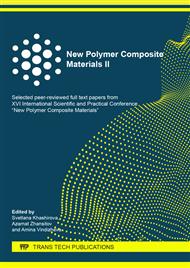[1]
Y. Li, J. Yang, J. Song, Structure models and nano energy system design for proton exchange membrane fuel cells in electric energy vehicles, Renewable and Sustainable Energy Reviews. 67 (2017) 160-172.
DOI: 10.1016/j.rser.2016.09.030
Google Scholar
[2]
G. Wang, et al., Progress on design and development of polymer electrolyte membrane fuel cell systems for vehicle applications: A review, Fuel Processing Technology. 179 (2018) 203-228.
DOI: 10.1016/j.fuproc.2018.06.013
Google Scholar
[3]
R. Wlodarczyk, Carbon-based materials for bipolar plates for low-temperatures PEM fuel cells, Functional Materials Letters. 12 (2019) 1930001.
DOI: 10.1142/s1793604719300019
Google Scholar
[4]
N. Guo, M.C. Leu, Effect of different graphite materials on the electrical conductivity and flexural strength of bipolar plates fabricated using selective laser sintering, International journal of hydrogen energy. 37 (2012) 3558-3566.
DOI: 10.1016/j.ijhydene.2011.11.058
Google Scholar
[5]
N.A.M. Radzuan, et al., The effect of milled carbon fibre filler on electrical conductivity in highly conductive polymer composites, Composites Part B: Engineering. 110 (2017) 153-160.
DOI: 10.1016/j.compositesb.2016.11.021
Google Scholar
[6]
J. Zhu, Carbon black-reinforced 3D and 4D printable conductive polymer composites, 3D and 4D Printing of Polymer Nanocomposite Materials. Elsevier. (2020) 367-385.
DOI: 10.1016/b978-0-12-816805-9.00012-0
Google Scholar
[7]
D. Prasanna, V. Selvaraj, Cyclophosphazene based conductive polymer-carbon nanotube composite as novel supporting material for methanol fuel cell applications, Journal of colloid and interface science. 472 (2016) 116-125.
DOI: 10.1016/j.jcis.2016.03.032
Google Scholar
[8]
L. Flandin, et al., Effect of strain on the properties of an ethylene-octene elastomer with conductive carbon fillers, Journal of Applied Polymer Science. 76 (2000) 894-905.
DOI: 10.1002/(sici)1097-4628(20000509)76:6<894::aid-app16>3.0.co;2-k
Google Scholar
[9]
R. Taherian, A review of composite and metallic bipolar plates in proton exchange membrane fuel cell: Materials, fabrication, and material selection, Journal of Power Sources. 265 (2014) 370-390.
DOI: 10.1016/j.jpowsour.2014.04.081
Google Scholar
[10]
A. Mukherjee, M.J. Dumont, V. Raghavan, Sustainable production of hydroxymethylfurfural and levulinic acid: Challenges and opportunities, Biomass and Bioenergy. 72 (2015) 143-183.
DOI: 10.1016/j.biombioe.2014.11.007
Google Scholar
[11]
B.R. Caes, et al., Biomass to furanics: renewable routes to chemicals and fuels, ACS Sustainable Chemistry & Engineering. 3 (2015) 2591-2605.
DOI: 10.1021/acssuschemeng.5b00473
Google Scholar
[12]
P.K. Rout, et al., Synthesis of hydroxymethylfurfural from cellulose using green processes: A promising biochemical and biofuel feedstock, Chemical Engineering Science. 142 (2016) 318-346.
DOI: 10.1016/j.ces.2015.12.002
Google Scholar
[13]
D.V. Chernysheva, et al., Sustainable utilization of biomass refinery wastes for accessing activated carbons and supercapacitor electrode materials, ChemSusChem. 11 (2018) 3599-3608.
DOI: 10.1002/cssc.201801757
Google Scholar
[14]
K.Yao, et al., Highly conductive and strong graphite-phenolic resin composite for bipolar plate applications, Energy & Fuels. 31 (2017) 14320-14331.
DOI: 10.1021/acs.energyfuels.7b02678
Google Scholar
[15]
V.A. Klushin, et al., Technological aspects of fructose conversion to high-purity 5-hydroxymethylfurfural, a versatile platform chemical, Russian Journal of Organic Chemistry. 52 (2016) 767-771.
DOI: 10.1134/s1070428016060014
Google Scholar
[16]
S.B. Lee, et al., Improved corrosion resistance and interfacial contact resistance of 316L stainless-steel for proton exchange membrane fuel cell bipolar plates by chromizing surface treatment, Journal of Power Sources. 187 (2009) 318-323.
DOI: 10.1016/j.jpowsour.2008.11.064
Google Scholar
[17]
B.K. Kakati, K.R. Guptha, A. Verma, Fabrication of composite bipolar plate for proton exchange membrane fuel cell, J. Environ Res Dev. 4 (2009) 202-211.
Google Scholar
[18]
Q. Yin, et al., Study on the electrical and mechanical properties of phenol formaldehyde resin/graphite composite for bipolar plate, Journal of power sources. 165 (2007) 717-721.
DOI: 10.1016/j.jpowsour.2006.12.019
Google Scholar
[19]
R.K. Gautam, K.K. Kar, Synergistic effects of carbon fillers of phenolic resin based composite bipolar plates on the performance of PEM fuel cell, Fuel Cells. 16 (2016) 179-192.
DOI: 10.1002/fuce.201500051
Google Scholar
[20]
N.B. Brandt, S.M. Chudinov, Y.G. Ponomarev (ed.), Semimetals: 1. Graphite and its Compounds. Elsevier, (2012).
Google Scholar
[21]
M. Ardanuy, M.A. Rodríguez-Perez, I. Algaba, Electrical conductivity and mechanical properties of vapor-grown carbon nanofibers/trifunctional epoxy composites prepared by direct mixing, Composites Part B: Engineering. 42 (2011) 675-681.
DOI: 10.1016/j.compositesb.2011.02.006
Google Scholar


